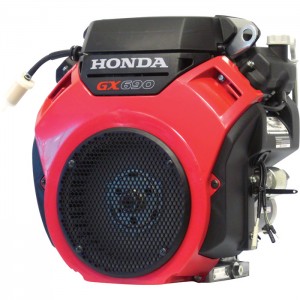Honda makes quality engines, but it takes steady maintenance for them to live up to their reputation for reliability. Here’s what you need to know to keep your GX 690 or GXV 690 V-Twin in top running condition.
Maintenance Schedule
These maintenance tasks are easy enough that you can do them yourself:
Before each use – Check air filter and oil level.
After the first month or 20 hours of operation – Change the oil.
Every 6 months or 100 hours – Change the oil, clean the air filter and check the spark plug. Clean the spark arrester if your engine has one (GX 690 only.)
Every 200 hours – Replace the oil filter.
Every year or 300 hours – Replace the spark plug.
Every two years or 500 hours – Replace the paper air filter element.
Honda recommends having a small engine mechanic handle these maintenance tasks:
Every year or 300 hours – Check the idle speed and valve clearance, and replace the fuel filter
Every two years – Check the fuel tube and replace as needed
Every 1,000 hours: Clean the combustion chamber (GXV 690 only.)
Oil
This engine is designed to use oil that meets the requirements for API category SJ or later. Honda recommends oil viscosity based on the temperatures the engine will be operating in:
SAE 30 – 50-113ºF (10-45ºC)
Conventional 5W30 or 10W30 – 23-113ºF (-5-45ºC)
Synthetic 5W30 – 5-113ºF(-15-45ºC)
To get an accurate measurement when checking the oil, place the engine on a level surface and let it run for a couple minutes. This will splash some oil on the dipstick, so it needs to be cleaned and inserted all the way into the filler neck before checking the oil level. Some versions of this engine come equipped with Oil Alert, which will shut off the ignition automatically if the oil level is too low.
To change the oil, remove the drain plug, located directly below the starter on the GX 690 and next to the filler neck on the GXV 690. Once the oil has drained, reinstall the drain plug and a new sealing washer. If your engine is due for a new filter, remove the old one with an oil filter wrench. Using a strap wrench can damage the oil pressure switch. Coat the seal on the new filter with clean engine oil before installing. Screw in the filter by hand, then use the wrench to turn the filter another ¾ turn once the filter seats. Pour new oil into the oil filler neck, located on the top of the cylinder directly to the left of the dipstick. Add oil until the level comes up to the upper limit mark on the dipstick. Start the engine and check for leaks.
Air Filter
To access the filter, pull up on the latches at the sides of the air cleaner cover and pull the cover away from the engine. The paper filter and surrounding foam element can be removed by unscrewing the wing nut on the GX 690, while they can be lifted straight out of the air box on the GXV 690.
To clean the paper element, tap it on a hard surface or blow it out with compressed air. When using air, limit the pressure to 30 psi.
To clean the foam element, wash it in a non-flammable solvent or soapy water. Once the filter is dry, soak it in clean engine oil and squeeze it out to remove any excess.
Before reinstalling the filters, wipe out the inside of the air cleaner box.
Spark Plug
To remove the spark plugs, first, clean the area around the spark plug caps and disconnect them from the plugs. Use a 5/8 inch plug wrench to unscrew the plugs.
The spark plug gap should be between 0.028 and 0.031 inches (0.7-0.8 mm.) Replace the plug if it’s damaged, corroded, has a worn electrode or the sealing washer is in poor condition.
Always start the spark plug by hand to prevent cross-threading. Once seated, use the wrench to turn the plug another ½ turn if it’s new or 1/8-1/4 turn if it’s used to get a tight seal. Reconnect the spark plug caps.
Spark Arrester
If your engine has a round high-mount muffler, simply remove the screw from the tailpipe and slide out the arrester. If your engine has a flat side-mount muffler, you’ll need to remove the four bolts holding the muffler protector. With the muffler uncovered, remove the three screws holding in the arrester.
Use a wire brush to scrub off any carbon deposits. Replace the arrester if it has signs of damage.
Keep Your Engine Running with Quality OEM Parts
Hondalawnparts.com is a certified dealer for Honda Engines, letting us sell the parts you need to maintain your Honda engine no matter what it’s powering. Not sure what you need? Just pick your model and serial number, and our site can show you diagrams and descriptions to locate parts on your engine. We ship to any address in the United States or Canada.


